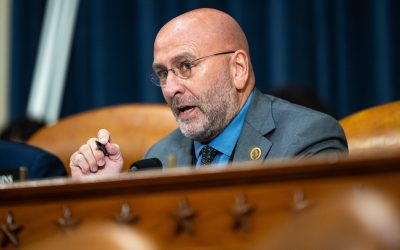Congressman Clay Higgins was in town today, and stopped by KATC to talk about two bills he has introduced aimed at improving school security.
The first, H.R. 5242, the School Resource Officer Assessment Act of 2018, calls on federal officials to gather data about the number of school resource officers in the nation’s public schools. This data is needed for a larger school security bill he’s working on that would create federal, state and private partnerships to fund improved security in public schools.
The aim is to bring about a “cultural change” in schools similar to the one that happened in airports following 9-11, Higgins said.
“What we envision is introducing legislation to encourage and mandate the kind of cultural change America went through after 9-11 regarding air travel. Airlines used to be soft targets, but after 9-11 things changed. Cockpits were hardened, doors were made bulletproof, pilots were armed, cockpits have weapons in them now, we expanded the air marshal service, checkpoints were put in with baggage screening equipment,” Higgins said. “There was a will amongst the American people to have the cultural change whereby airline travel would be protected, and go from a soft target to a hard target. I believe, and many of my colleagues believe, that we can have that kind of cultural change within our schools.”
Higgins said he believes the funding can be found to fund a larger more comprehensive bill, although he acknowledges that it’s a “massive undertaking,” considering that there are more than 95,000 public schools in America.
The second bill he’s working on is H.R. 5243, the School Watch and Training (SWAT) Act of 2018, which would set federal standards for tactical training for school resource officers.
Many resource officers have little to no training in tactics, he explained. Higgins said SWAT training is not just for weapons training, there’s tactical training that gives law enforcement officers skills they need in certain situations – like an active shooter situation.
“School resource officers by and large have a particular ability to communicate with kids, they have to have a great deal of patience, they know how to help young Americans make it through the difficult times of the teenage years,” he said. “It’s a special cop, a special man or woman who can be an SRO, and we want to maintain that as we move forward to address the challenge of protecting our schools. SROs by and large don’t have tactical training. It’s the tactics that are critical for an officer, even an officer who has been through patrol-level training to respond to an active shooter situation.
Higgins said the aim is not to turn schools into high-security prisons.
We don’t want our kids going to schools that look like prisons. We don’t want that,” Higgins said. “We want our children to feel the freedom and exhilaration of an educational environment, and this extends to the attire of a TSRO. For a SWAT officer – it’s not something you put on in the morning. It’s something that you’ve trained yourself to do and have a skill to perform. They have the skills that allow them to be able to quickly and efficiently and professionally respond to an active shooter or a barricaded hostage.”
To read the text of the bills, click here.



